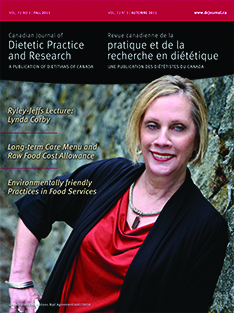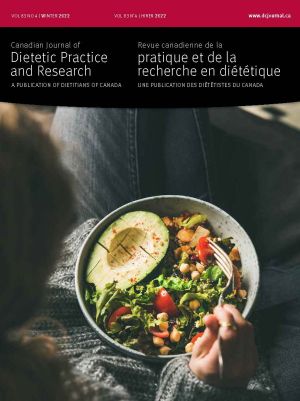Volume 72 • Number 3 • September 2011
Chair’s Message
Editor’s Message
Research
Purpose: Dietitian and consumer perspectives on nutrition education needs and preferences were explored, as these relate to health status. Methods: Phases 1 and 2 of a three-phase, mixed-methods study are reported. Phase 1 was a national online survey of dietitians, which was designed to inform the development of a consumer survey (Phase 2). Consumers responded to an online survey about their demographics, medical conditions, and nutrition education needs (what they wanted to learn) and preferences (how they wanted to learn). Phase 3 involved teleconferenced discussion groups with dietitians across Canada to develop guidelines for nutrition education. Results: Dietitian respondents (n=441) perceived that consumer health status was important in predicting needs and preferences for nutrition education; emotional support was considered most important for consumers with life-altering medical conditions. Consumers (n=680) expressed interest in an array of nutrition education approaches; cooking tips, recipes, and supplement advice were the most popular. Respondents with and without medical conditions had similar nutrition education needs and preferences. Conclusions: Because of the complexity of nutrition education and consumers’ preference for a spectrum of approaches and delivery methods, evidence-based nutrition education guidelines are important to inform dietetics training for the provision of client-centred nutrition education.
Purpose: There is increasing global interest in sustainability and the environment. A hospital/health care food service facility consumes large amounts of resources; therefore, efficiencies in operation can address sustainability. Beliefs, attitudes, and behaviours about environmentally friendly practices in hospital/ health care food services were explored in this study. Methods: Questionnaires addressed environmentally friendly initiatives in building and equipment, waste management, food, and non-food procurement issues. The 68 participants included hospital food service managers, clinical dietitians, dietary aides, food technicians, and senior management. Data analysis included correlation analysis and descriptive statistics. Results: Average scores for beliefs were high in building and equipment (90%), waste management (94%), and non-food procurement (87%), and lower in food-related initiatives (61%) such as buying locally, buying organic foods, buying sustainable fish products, and reducing animal proteins. Average positive scores for behaviours were positively correlated with beliefs (waste management, p=0.001; food, p=0.000; non-food procurement, p=0.002). Average positive scores for attitude in terms of implementing the initiatives in health care were 74% for building and equipment, 81% for waste management, 70% for non-food procurement, and 36% for food. Conclusions: The difference in food-related beliefs, behaviours, and attitudes suggests the need for education on environmental impacts of food choices. Research is recommended to determine facilitators and barriers to the implementation of green strategies in health care. As food experts, dietitians can lead changes in education, practice, and policy development.
Purpose: Little is known about how food is managed in households where food resources are scarce. In this study, the household food management behaviours utilized by foodinsecure, lone mother-led families from Atlantic Canada were characterized, and relationships among these behaviours and diet quality were examined. Methods: Thematic analysis of 24 in-depth interviews from a larger study of mother-led, low-income families was integrated with sociodemographic characteristics, food-insecurity status, and four weekly 24-hour dietary recalls for all household members to yield a family behaviour score (FBS) as a summative measure of food management behaviours, and a healthy plate score (HPS) as a measure of diet quality. Results: Five distinct food management behaviours were identified: authoritative, healthism, sharing, structured, and planning behaviours. An increase in the FBS was associated with a proportional increase in the HPS. Authoritative, healthism, and planning food management behaviours were the strongest predictors of the HPS for all household members (p<0.05). The structured management behaviour was related to the degree of food insecurity. Conclusions: The FBS and HPS tools hold promise as a way to identify food-insecure families at risk of low diet quality. The next phase of this research will validate the use of these tools in the practice setting.
Purpose: Through consultation with Canadian dietitian informants, we aimed to identify the desired knowledge, skills, and attitudes (KSA) for preceptors, training opportunities, and the barriers that prevent preceptor training. Methods: In this qualitative study, an open-ended survey was sent electronically to 100 key informants across Canada. Informants had experience as preceptors or with dietitian preceptors. Informants were asked to reflect upon the desired KSA, training needs, and barriers to training for dietitian preceptors. Categories of responses under each of these headings were developed on the basis of informants’ responses. Results: Forty-nine key informants completed the survey, for a 49% response rate. Of the respondents, 41% (20/49) were in clinical practice and 35% (17/49) worked in community/public health areas. The knowledge and skills domains consisted of themes related to teaching and learning, including assessing, planning, and evaluating. Attitudes expressed included considering learners as colleagues and the training of learners as a professional responsibility. Perceived barriers to training preceptors included workload demands and a lack of recognition from peers and employers for this work. Dietitian preceptor training opportunities ranged from no training to formal programs. Conclusions: These findings are integral to the basic understanding of the desired KSA and training needs of Canadian dietitian preceptors.
Purpose: The clustering of specific health-related behaviours was examined among adolescents. Methods: In 2005, cluster analysis was conducted to identify homogeneous groups of Toronto, Ontario, 14- to 17-year-old adolescents (n=445) with similar behaviour patterns according to self-reported measures of moderate to vigorous physical activity (metabolic equivalent [MET] hours a week of MVPA), sedentary behaviours (viewing television or videos, using a computer/the internet, doing homework, and talking with friends), fruit and vegetable consumption, and alcohol consumption. Results: Three clusters of adolescents were identified: “active, high screen-time users,” “active, low screen-time users,” and “less active, least frequent drinkers.” Conclusions: Identifying clusters of adolescents with similar health-related behaviour patterns suggests that researchers and practitioners should develop and implement interventions tailored to specific clusters.
Purpose: Dietary patterns of food consumption were investigated among young urban Toronto adults, including men and women from different ethnocultural groups. Methods: We performed a cross-sectional analysis among 1153 adults aged 20 to 29 years, from the Toronto Nutrigenomics and Health Study. Principal components analysis of food intake scores was used to identify food consumption patterns. Logistic regression, analysis of variance, and t-tests were used to test for differences in dietary patterns between ethnocultural groups and between men and women. Partial correlations were used to investigate the relationship between patterns and nutrient intake. Results: Three predominant patterns were identified and termed “prudent,” “Western,” and “Eastern” patterns. Caucasians had significantly higher prudent pattern scores than did Asians and South Asians, while Asians had significantly higher Eastern pattern scores than did other ethnocultural groups (p<0.01). Women had higher prudent pattern scores (odds ratio [OR]=4.31, 95% confidence interval [CI]=3.11-5.96) and lower Western pattern scores (OR=0.62, 95% CI=0.45-0.84) than did men. Dietary pattern scores were correlated with nutrient and energy intakes. Conclusions: We observed distinct dietary patterns in this population of young adults. These dietary patterns varied significantly between ethnocultural groups and between men and women. The patterns were associated with nutrient intake levels; this association may have important public health implications.
Report
Purpose: This study was conducted to explore whether preparing more complex meals was associated with higher food security status. Methods: This mixed-methods, community-based study involved the use of semistructured interviews to examine the cooking practices of a group of young, low-income women in Montreal. Fifty participants aged 18 to 35 were recruited at 10 locations in five low-income neighbourhoods. Food security status was the main outcome measure and the main exposure variable, “complex food preparation,” combined the preparation of three specific food types (soups, sauces, and baked goods) using basic ingredients. Results: Low-income women preparing a variety of meals using basic ingredients at least three times a week were more than twice as likely to be food secure as were women preparing more complex meals less frequently. Conclusions: Women who prepared more complex meals more frequently had higher food security. Whether this means that preparing more complex foods results in greater food security remains unclear, as this was an exploratory study.
Purpose: In June 2008, the Alberta government released the Alberta Nutrition Guidelines for Children and Youth. We evaluated the awareness of and intent to use the guidelines in Alberta schools, and sought to determine whether organizational characteristics were a factor in adoption of the guidelines. Methods: Randomly selected schools from across Alberta completed a 19-question telephone survey, which included open- and closed-ended questions about the schools’ characteristics, the priority given to healthy eating, awareness of the guidelines, and the schools’ intent to use the guidelines. Of the 554 schools contacted, 357 (64%) completed the survey. Results: Overall, 76.1% of schools were aware of the guidelines and 65% were in the process of adopting them. Fifty percent of schools identified healthy eating as a high priority and 65.9% reported making changes to improve the nutritional quality of foods offered in the past year. Schools that were larger, public, and urban, and had a school champion and healthy eating as a high priority were more likely to be adopting the guidelines. Conclusions: Most schools were aware of the nutrition guidelines and many had begun the adoption process. Identifying a school champion may be an important first step for schools in terms of adopting health promotion initiatives.
Purpose: Regular, nontherapeutic menus were compared before and after an increase in the Ontario long-term care (LTC) raw food cost allowance (RFCA). The purpose was to determine whether any significant nutritional differences existed between the old and new menus and whether they met target values for adequacy, according to the Dietary Reference Intake (DRI) nutrient recommendations or other target values relevant to Ministry of Health and Long-Term Care standards. Methods: A southeastern Ontario LTC facility fall/winter 2006/2007 menu and fall/winter 2007/2008 menu were used for nutrient analysis with ESHA Food Processor SQL 10.1.0. Each menu was compared with target values based on Canada's Food Guide (CFG) for 1992 and 2007, and with DRI nutrient recommendations. Results: The 2007/2008 menu provided significantly more servings of vegetables and fruit, meeting the 2007 CFG recommendations, and significantly greater amounts of some nutrients (e.g., vitamin C, protein, magnesium, potassium, fibre, and total water). It also came closer to meeting DRI target recommendations. Conclusions: While some improvements have been made to the menu in this specific facility, further improvements, possibly through supplementation, must be made to ensure nutritional adequacy for all residents.
Recognition
OPEN ACCESS
Change is the one constant in a constantly changing world, including the world of dietetic practice. Over a 40-year career, I have witnessed and participated in many such changes. Key lessons from my early career with Manitoba Agriculture and Manitoba Health include an understanding of the power of teamwork, of the importance of communication skills, of the need for shared knowledge and expertise, and of ways to connect nutrition messages with food and eating. Later, my work as director of education in a family medicine residency program taught me the value of building a portfolio of knowledge and skills and of working with families. Similarly, my work with the Organization for Cooperation in Overseas Development led me to appreciate the need for cultural sensitivity in our work. Opportunities with Dietitians of Canada have shown me that future directions must include continued interdisciplinary development of policy and position papers. Other important challenges include determining issues relevant to various areas of dietetic practice, working to achieve Vision 2020 goals, and inspiring and nurturing new leadership among younger Dietitians of Canada members.
Canadian Foundation for Dietetic Research
OPEN ACCESS
I wish to welcome everyone to Edmonton and the 2011 Dietitians of Canada Annual Conference Research Event. This year we have over 600 participants attending the conference with over 80 research posters and oral presentations that span topics from clinical nutrition to food policy to research methodology to community nutrition and dietetic practice and education. This year the breadth of research was very strong indicating the strong role that dietitians play in conducting evidenced based nutrition research that supports dietetic practice in all areas of professional practice. I wish to congratulate each and every presenter for sharing their research and for all their hard work. This year we will continue with the Poster Tours. These tours allow each presenter to discuss the highlights of his/her research under the guidance of one of the abstract review committee members and/or graduate students. These sessions are very interactive and also provide those attending the tours the opportunity to network with other dietetic researchers in Canada. We hope that you will enjoy these tours once again. On behalf of the membership of Dietitians of Canada, I would like to thank the Abstracts Review Committee members who took the time from their busy schedules to provide their expertise to review these abstracts. Our abstract committee represented a broad spectrum of dietetic expertise from professional practice sectors across Canada. I wish to thank them for their hard work. Thanks go to: Dr(s) Kate Storey, Laura Forbes, Justine Turner, Anna Farmer, Michelle MacKenzie, Vera Mazurak and Heidi Bates from the University of Alberta, Lyn Zuberbuhler and Tanis Fenton from Alberta Health Services, Alice Lee from Covenant Health, Roula Tzianetas from Mount Sinai Hospital, Roseann Nasser from Regina Qu'Appelle Health Region, Dr Christine Lengyel from the University of Manitoba and Dr. Frances Rioux from the University of Ottawa. I would also like to acknowledge the Canadian Foundation for Dietetic Research and Dietitians of Canada for their ongoing support of practice based research in Canada and for their vision of supporting dietetic training and research in this important area of practice. Please join me in celebrating Canadian Dietetic Research by attending the poster presentations on Thursday and Friday (June 16 and 17) and the oral presentations on Friday, June 17 in the afternoon.










